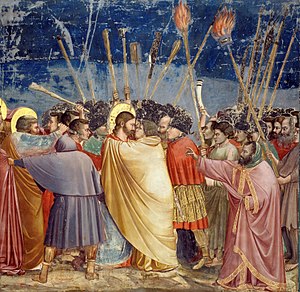Kiss of Judas

According to the Synoptic Gospels, Judas identified Jesus to the soldiers by means of a kiss. This is the kiss of Judas, also known (especially in art) as the Betrayal of Christ, which occurs in the Garden of Gethsemane after the Last Supper, and leads directly to the arrest of Jesus by the police force of the Sanhedrin (Kilgallen 271). In Christian theology, the events from the Last Supper until the death and resurrection of Jesus are referred to as The Passion.
More broadly, a Judas kiss may refer to "an act appearing to be an act of friendship, which is in fact harmful to the recipient."[1] The related phrase Judas wage refers to a payment or reward for treachery or betrayal.[2]
In the New Testament
Both Matthew (26:47–50) and Mark (14:43–45) use the Greek verb kataphilein, which means to kiss firmly, intensely, passionately, tenderly or warmly. It is the same verb that Plutarch uses to describe a famous kiss that Alexander the Great gave Bagoas.[3] According to John, Jesus responded by saying "Friend, do what you are here to do." This has caused speculation that Jesus and Judas were actually in agreement with each other and there was no real betrayal.[4] Luke (22:47–48) presents a very different picture: Jesus sees Judas coming and stops him by asking: "Judas, are you betraying the son of man with a kiss?" The kiss is apparently not delivered at all. Geza Vermes, however, in his book Jesus the Jew, presents a very different view: The Aramaic word barnasha—literally "son of man" but meaning "this person"—is used in Rabbinic literature as a humble, self-effacing way to refer to oneself, to the speaker. It corresponds exactly to the Japanese word sessha, "this one," an old-fashioned way to say "I" or "me" when talking to a superior. Jesus would be saying "You would use a kiss to betray me?"
In the Gospel of John, nothing at all is said about the kiss of Judas. In the Gospel of Luke this episode is immediately followed by the healing the ear of a servant.
In art

The scene is nearly always included, either as the Kiss itself, or the moment after, the Arrest of Jesus, or the two combined (as above), in cycles of the Life of Christ or Passion of Jesus in various media.
- Probably the best known is from Giotto's cycle in the Scrovegni Chapel in Padua.
- There is also a version called The Taking of Christ by Caravaggio or one of his disciples.[5]
- A sixth-century Byzantine Mosaic in Ravenna.
- A fresco by Barna da Siena.
- A sculpture representing the Kiss of Judas appears on the Passion façade of the Sagrada Família.
See also
References
- ^ Thefreedictionary.com
- ^ One example of the use of this phrase was by Adolf Hitler in his 12th September 1923 Munich speech: "For he knows what we can only guess, how in the war the millions of gold poured into Germany, how they began to take effect, how great associations of traitors were formed through foreign gold - through his gold. And now he sees face to face the man to whom before he paid out the Judas-wage."
- ^ Plutarch, Parallel Lives, Alexander, 67
- ^ Pagels, Elaine at Karen L. King. (...) "The Gospel of John suggests that Jesus himself was complicit in the betrayal, that moments before Judas went out, Jesus had told him, "Do quickly what you are going to do" (John 13:27)" (...), Reading Judas, The Gospel of Judas and the Shaping of Christianity, Penguin Books, New York, 2007, pages 3–4, ISBN 9780143113164.
- ^ For a discussion of the kiss of Judas with respect to Caravaggio's The Taking of Christ (now in the National Gallery of Ireland, Dublin), together with a summary of traditional ecclesiastical interpretation of that gesture, see Franco Mormando, "Just as your lips approach the lips of your brothers: Judas Iscariot and the Kiss of Betrayal" in Saints and Sinners: Caravaggio and the Baroque Image, ed. F. Mormando, Chestnut Hill, MA: The McMullen Museum of Art of Boston College, 1999, 179–90.
Further reading
- Grubb, Nancy (1996). The Life of Christ. New York City: Abbeville Publishing Group. ISBN 0-7892-0144-5. OCLC 34412342.[page needed]
